Review: Coffee Joulies
My Coffee Joulies just arrived from the first batch of shipments to its Kickstarter backers. The little card that comes with them gives a good description of what they’re supposed to do:
Place Joulies in your cup before pouring your coffee and it will be ready to drink three times sooner and will remain hot twice as long.
See their original Kickstarter page for information as well.
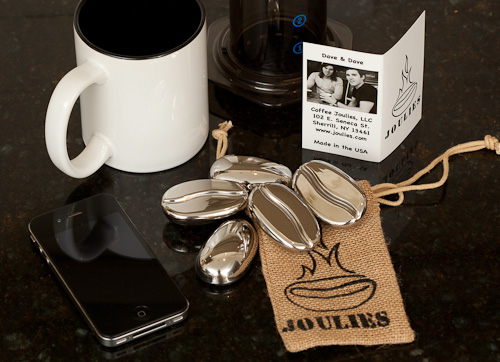
How hard could it be to photograph a bunch of black, white, and highly reflective objects on a reflective black surface with a 100mm lens indoors?
They look great.1 They’re also much larger than I expected, although that’s not a bad thing.
These feel like extremely high-quality items, and they also don’t impart any metallic taste that I can detect. They seem very well-made.
Their site details their intended thermal behavior:
- First, they absorb energy from your coffee when it is too hot, cooling it down to a drinkable temperature three times faster
- Next, they release that stored energy back into your coffee keeping it in the right temperature range twice as long
As we discussed on my podcast when they were announced, they contain a phase-change material (PCM) with a melting temperature of around 140 degrees Fahrenheit, supposedly the ideal coffee-drinking temperature. Wikipedia explains how it works:
Initially, the solid-liquid PCMs behave like sensible heat storage (SHS) materials; their temperature rises as they absorb heat. Unlike conventional SHS, however, when PCMs reach the temperature at which they change phase (their melting temperature) they absorb large amounts of heat at an almost constant temperature. The PCM continues to absorb heat without a significant rise in temperature until all the material is transformed to the liquid phase. When the ambient temperature around a liquid material falls, the PCM solidifies, releasing its stored latent heat. … They store 5 to 14 times more heat per unit volume than conventional storage materials such as water, masonry or rock.
Sounds good. Let’s see how well it works.
I first tested them in a common scenario: putting room-temperature Joulies in room-temperature mugs, pouring matching amounts of boiling water into a control mug and the Joulies-equipped mug of each type, and measuring the water temperatures every 2 minutes until both mugs in each pair fell below 110ºF (which I consider too tepid to comfortably drink).

This is not lab-precision equipment, and these were not lab conditions. I couldn’t, for instance, measure both cups’ temperatures exactly simultaneously, so I alternated the thermometer between mugs until its temperature stabilized in each (about 10 seconds). I poured the water in the same sequence with the same delay between the two mugs, so any skew from this should be minimal. Regardless, the measurements I’ve taken should be considered approximations.
First, the results from my favorite insulated mug for road trips, the Contigo 16-ounce travel mug:
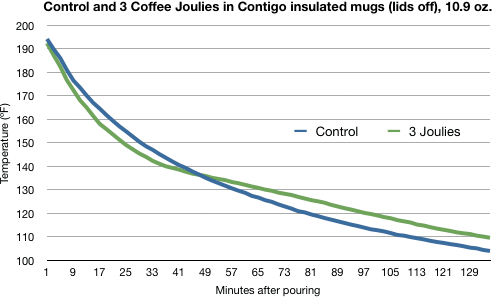
Keep in mind that the lids were off for the constant thermal probing, so they lost heat to the air much faster than they would if they were sealed.
You can see the effect of the Joulies: the temperature in their mug dropped faster than the control mug, then slowed its drop noticeably at around 140ºF, exactly as designed. The temperatures soon started dropping at about the same rate, but the mug with the Joulies was slightly warmer.
The control mug reached 140º at 43 minutes, and the mug with Joulies reached it at 37 minutes.
The control mug fell below 110º at 111 minutes, and the mug with Joulies fell below at 135 minutes.
The effect is present, but weak. And it’s worse in ceramic mugs, where much more heat is lost to the mug’s walls, the surface it’s sitting on, and the surrounding air:
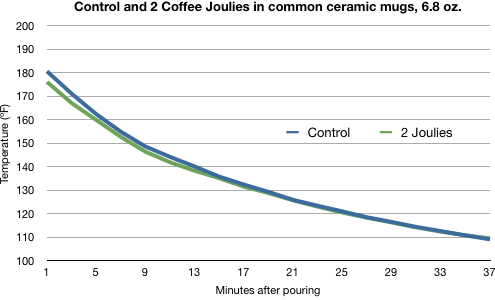
The control mug reached 140º at 13 minutes, and the mug with Joulies reached it at about 12 minutes. Both mugs fell below 110º at 37 minutes.
This wasn’t looking good for the Joulies, but to give them another shot, I created a favorable scenario: after everything reached room temperature again, I ran another test using all five Joulies in a ceramic mug, and warmed the Julies in some hot tap water first.
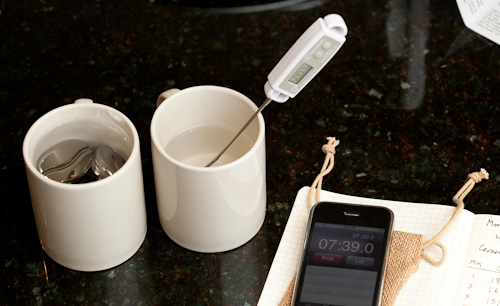
The results were more amplified, but ultimately didn’t help the Joulies much:
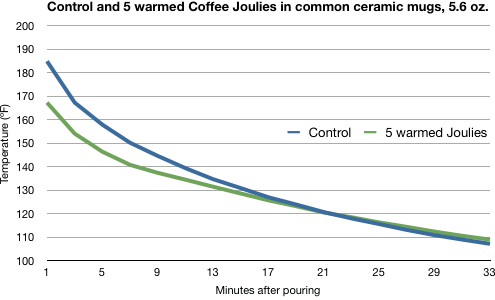
The control mug reached 140º at 11 minutes, and the mug with Joulies reached it at 7 minutes. The large gap at the start is most likely due to the huge mass of Joulies absorbing so much of the initial heat.
The control mug fell below 110º at 31 minutes. The mug with Joulies fell below at 33 minutes. (I expect these were worse than the previous ceramic test because of the smaller water volume that would fit in the mug with all of those Joulies.)
I could do more tests with different conditions,2 but I honestly don’t want to spend another four hours to reinforce what seems pretty clear already: Coffee Joulies do work, but their effect isn’t very strong, and it’s nowhere near their claims that the drink “will be ready to drink three times sooner and will remain hot twice as long.” In fact, the effect is barely noticeable.
I imagine they’d fare well in an all-day test in a vacuum mug or bottle, but the effect is going to be similar to my insulated-mug test: an improvement, but not by much.
Their website is already playing down their benefits with regular mugs with statements like this:
IN A GOOD VACUUM TRAVEL MUG YOUR COFFEE WILL BE THE RIGHT TEMPERATURE IN MINUTES AND WILL STAY THAT WAY FOR HOURS
But that statement is just as true without Coffee Joulies: good vacuum mugs like my trusty Contigo already keep liquids at hot (or cold) temperatures for far longer than most people expect.
While Joulies may help a bit, they’re probably not worth their cost to do so. (I don’t know what their final retail cost will be, but their cost on Kickstarter was $40.) And in addition to the cost, there are other downsides to using them:
- They’re more things to wash.
- They consume a nontrivial amount of volume, so you can fit less liquid in your mug or bottle when using them.
- When nearing the end of a drink in an open-topped mug, they can suddenly separate and crash into your nose, just like ice cubes.
I wish Joulies had more of an effect, especially in the common mug-on-a-desk scenario. I was excited for this project since I saw it on Kickstarter, and the creators seem like nice, hopeful guys. I honestly feel bad for them — I really wanted their product to be great, but I can’t recommend it.
If anything, this should convince you of the value of a good travel mug.
-
Yes, their instruction card is printed entirely in Comic Sans. But I won’t hold that against them because the Joulies look so good. ↩︎
-
Some ideas for more tests: using Joulies that had sat in boiling water for a while to be as hot as possible; testing with two good vacuum bottles over 8 hours; comparing the performance of Joulies to equal masses of rocks or metal. ↩︎